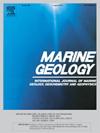Submarine canyon sediment transport and accumulation during sea level highstand: Interactive seasonal regimes in the head of Astoria Canyon, WA
IF 2.2
3区 地球科学
Q2 GEOSCIENCES, MULTIDISCIPLINARY
引用次数: 0
Abstract
The majority of submarine canyons on Earth today do not directly intersect littoral or fluvial sediment sources, yet these systems are rarely studied. The shelf-incised head of Astoria Canyon receives sediment from the nearby Columbia River and is subject to energetic forcing from shelf and slope processes, making it an ideal site to evaluate the modern activity of canyons in high-stand sea level conditions. This study uses in-situ data from Astoria Canyon to identify the active sediment transport processes and patterns of accumulation in temperate canyon systems that are decoupled from their sediment sources during sea level highstand. Hydrodynamic data from a benthic tripod deployment in the head of Astoria Canyon shows that sediment resuspension and transport during summer is driven by internal tides and plume-associated nonlinear internal waves. Observations of shoreward-directed currents and low shear stresses (<0.14 Pa) along with sediment trap data suggest that seasonal loading of the canyon head occurs during summer. Nearby long-term wave data show that winter storm significant wave height often exceeds 10 m, driving shear stress capable of resuspending all grain sizes present within the canyon head. Swell events are generally concurrent with downwelling flows, providing a mechanism for episodic downcanyon sediment flux. Century-scale accumulation rates evaluated from sediment cores show slow accumulation in the upper canyon head, but rates progressively increase with depth to at least 300 m. The depositional environment in Astoria Canyon continues to respond to fluvial and oceanic forcing over an annual cycle. This study indicates that canyon heads can continue to function as sites of sediment winnowing and bottom boundary layer export even with a detached, shelf-depth canyon head.
海平面高水位期间海底峡谷沉积物的运输和积累:西澳阿斯托里亚峡谷头部的交互季节制度
今天地球上的大多数海底峡谷并不直接与沿海或河流沉积物源相交,但这些系统很少被研究。阿斯托里亚峡谷的陆架切割头部接收来自附近哥伦比亚河的沉积物,并受到陆架和斜坡过程的能量强迫,使其成为评估高海拔条件下峡谷现代活动的理想场所。本研究利用阿斯托里亚峡谷的原位数据,确定了海平面高水位期间与沉积物源解耦的温带峡谷系统的活跃沉积物输运过程和沉积模式。在阿斯托里亚峡谷头部部署的底栖三脚架的水动力学数据表明,夏季沉积物的再悬浮和运输是由内部潮汐和与羽流相关的非线性内波驱动的。对朝岸水流和低剪应力(<0.14 Pa)的观测以及沉积物捕集器数据表明,峡谷头部的季节性负荷发生在夏季。附近的长期波浪数据表明,冬季风暴的有效波高经常超过10米,驱动的剪切应力能够重新悬浮峡谷头部内存在的所有颗粒大小。膨胀事件通常与下行流动同时发生,这为峡谷下游沉积物的幕式流动提供了一种机制。从沉积物岩心评估的世纪累积速率显示,峡谷顶部的累积速度缓慢,但随着深度的增加,累积速率逐渐增加到至少300米。阿斯托里亚峡谷的沉积环境在一年的周期内继续对河流和海洋的作用力作出反应。该研究表明,即使有分离的陆架深度峡谷头,峡谷头也可以继续作为沉积物簸积和底边界层输出的场所。
本文章由计算机程序翻译,如有差异,请以英文原文为准。
求助全文
约1分钟内获得全文
求助全文
来源期刊

Marine Geology
地学-地球科学综合
CiteScore
6.10
自引率
6.90%
发文量
175
审稿时长
21.9 weeks
期刊介绍:
Marine Geology is the premier international journal on marine geological processes in the broadest sense. We seek papers that are comprehensive, interdisciplinary and synthetic that will be lasting contributions to the field. Although most papers are based on regional studies, they must demonstrate new findings of international significance. We accept papers on subjects as diverse as seafloor hydrothermal systems, beach dynamics, early diagenesis, microbiological studies in sediments, palaeoclimate studies and geophysical studies of the seabed. We encourage papers that address emerging new fields, for example the influence of anthropogenic processes on coastal/marine geology and coastal/marine geoarchaeology. We insist that the papers are concerned with the marine realm and that they deal with geology: with rocks, sediments, and physical and chemical processes affecting them. Papers should address scientific hypotheses: highly descriptive data compilations or papers that deal only with marine management and risk assessment should be submitted to other journals. Papers on laboratory or modelling studies must demonstrate direct relevance to marine processes or deposits. The primary criteria for acceptance of papers is that the science is of high quality, novel, significant, and of broad international interest.
 求助内容:
求助内容: 应助结果提醒方式:
应助结果提醒方式:


